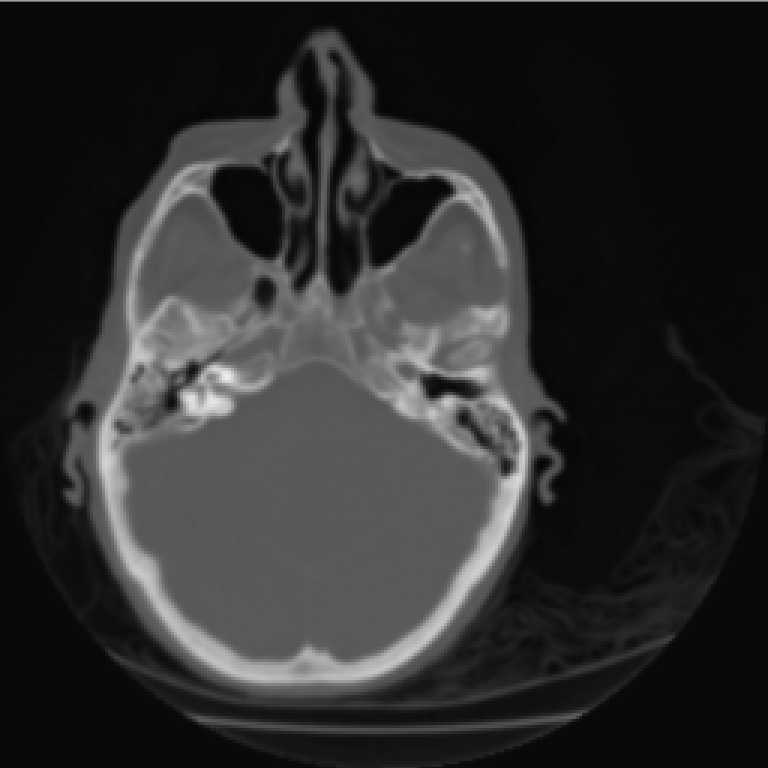3차원 이미지를 처리해보자.
2018, Jul 12
지금까지 포스팅은 2차원 이미지를 다뤘다. 이미지 구조가 3차원인 데이터를 처리하는 방법을 알아보자. 먼저 mfc 프로젝트를 생성한다. 나같은 경우 VolumeRenderer 이름으로 생성했다. 이미지가 z-index 를 가지는 Volume 형태이기 때문이다.
프로젝트가 실행되면 미리 준비한 3차원 데이터 “data\Bighead.den” 을 불러오도록 한다.
VolumeRendererDoc.cpp
Bool CVolumeRendererDoc::OnNewDocument()
{
if (!CDocument::OnNewDocument())
return FALSE;
// TODO: 여기에 재초기화 코드를 추가합니다.
// SDI 문서는 이 문서를 다시 사용합니다.
// 새 창이 뜨면 data를 불러와 버퍼에 저장한다.
FILE* fp;
fopen_s(&fp, "data//Bighead.den", "rb");
// volume 사이즈를 미리 계산해 둔 것이다.
int width = 256;
int height = 256;
int depth = 256;
unsigned char* temp_vol = new unsigned char[width*height*depth];
fread(temp_vol, 1, sizeof(unsigned char)*width*height*depth, fp);
// 클래스 변수에 볼륨을 저장하고 pointer 변수가 이를 가리키게 한다.
m_pVolume = shared_ptr<Volume>(new Volume(temp_vol,width,height,depth));
fclose(fp);
delete[] temp_vol;
printf("volume load complete\n");
return TRUE;
}위 코드에서 사용한 클래스 변수를 정의하고 선언하자
Volume.h
#pragma once
// shared_ptr 사용하려면 추가
#include <memory>
using namespace std;
class Volume
{
private:
shared_ptr<unsigned char> m_volume;
int m_width;
int m_height;
int m_depth;
public:
Volume();
// volume 을 받으면 메모리 생성하고 volume 의 내용을 카피한다.
Volume(unsigned char* volume, int width, int height, int depth);
~Volume();
public:
// 인자 좌표에 해당하는 voxel 을 반환한다.
unsigned char getVoxel(int x, int y, int z);
int getWidth();
int getHeight();
int getDepth();
};Volume.cpp
#include "stdafx.h"
#include "Volume.h"
Volume::Volume()
{
m_volume = nullptr;
}
Volume::Volume(unsigned char* volume, int width, int height, int depth)
{
m_volume = shared_ptr<unsigned char>(
new unsigned char[width*height*depth]);
// m_volume.get() 하면 shared_ptr이 가리키는 배열의 주소가 반환된다.
memcpy(m_volume.get(), volume, sizeof(unsigned char)*width*height*depth);
m_width = width;
m_height = height;
m_depth = depth;
}
Volume::~Volume()
{
}
unsigned char Volume::getVoxel(int x, int y, int z)
{
// return m_volume[z][y][x]
return m_volume.get()[m_width*m_height*z + m_width * y + x];
}
int Volume::getWidth()
{
return m_width;
}
int Volume::getHeight()
{
return m_height;
}
int Volume::getDepth()
{
return m_depth;
}이제 VolumeRendererDoc.cpp 에서 Volume 클래스를 사용할 수 있도록 선언해주자.
VolumeRendererDoc.h
//shared_ptr 사용하려면 아래와 같이 선언
#include <memory>
// Volume 클래스를 사용하기 위해 선언
#include "Volume.h"
using namespace std;
class CVolumeRendererDoc : public CDocument
{
...
private:
//shared_ptr을 이용하여 Volume 클래스 포인터를 선언한다.
shared_ptr<Volume> m_pVolume;
...
}3 차원 이미지를 Z-index 방향으로 자른 단면을 보여주는 기능을 만들어보자
VolumeRendererDoc.cpp
// volume 을 z 방향으로 자른 단면을 보여주는 기능
void CVolumeRendererDoc::OnSlicerenderingZdirection()
{
// TODO: 여기에 명령 처리기 코드를 추가합니다.
// 단면의 화면 버퍼를 만든다.
int img_width = m_pVolume->getWidth();
int img_height = m_pVolume->getHeight();
shared_ptr<unsigned char> image =
shared_ptr<unsigned char>(new unsigned char[img_width*img_height]);
// 버퍼에 단면정보를 저장한다.
for (int j = 0; j < img_height; j++)
{
for (int i = 0; i < img_width; i++)
{
// z-index 120 인 화면의 단면 정보를 저장한다.
image.get()[img_width*j + i] = m_pVolume->getVoxel(i, j, 120);
}
}
CVolumeRendererView* pView =
(CVolumeRendererView*)((CMainFrame*)(AfxGetApp()->m_pMainWnd))->GetActiveView();
pView->SetDrawImage(image.get(), img_width, img_height, 1);
pView->OnInitialUpdate();
}위에서 쓰인 함수 SetDrawImage 와 화면 그릴때 쓰는 함수인 OnDraw 함수를 정의해준다.
VolumeRendererView.cpp
...
CVolumeRendererView::CVolumeRendererView()
{
// TODO: 여기에 생성 코드를 추가합니다.
// 화면 사이즈와 그려야 할 데이터를 정의한다.
m_Image = nullptr;
m_ImgWidth = 768;
m_ImgHeight = 768;
m_Image =
shared_ptr<unsigned char>(new unsigned char[m_ImgWidth*m_ImgHeight*4]);
memset(m_Image.get(), 0, sizeof(unsigned char)*m_ImgWidth*m_ImgHeight * 4);
}
...
// 인자로 받은 image를 화면 사이즈에 맞춰 그린다.
void CVolumeRendererView::SetDrawImage(unsigned char* image,
const int width, const int height, const int byte)
{
// 화면에 대한 이미지의 비율을 구한다.
float rate[2] = { 0.f };
rate[0] = static_cast<float>(width) / static_cast<float>(m_ImgWidth);
rate[1] = static_cast<float>(height) / static_cast<float>(m_ImgHeight);
if (byte == 1)
{
for (int j = 0; j < m_ImgHeight; j++)
{
for (int i = 0; i < m_ImgWidth; i++)
{
int mode[2] = { 0 };
mode[0] = rate[0] * i; mode[1] = rate[1] * j;
if (mode[0] >= width || mode[1] >= height) continue;
m_Image.get()[(m_ImgWidth*j + i) * 4 + 0] = image[width*mode[1] + mode[0]];
m_Image.get()[(m_ImgWidth*j + i) * 4 + 1] = image[width*mode[1] + mode[0]];
m_Image.get()[(m_ImgWidth*j + i) * 4 + 2] = image[width*mode[1] + mode[0]];
}
}
}
else
{
for (int j = 0; j < m_ImgHeight; j++)
{
for (int i = 0; i < m_ImgWidth; i++)
{
int mode[2] = { 0 };
mode[0] = rate[0] * i; mode[1] = rate[1] * j;
if (mode[0] >= width || mode[1] >= height) continue;
m_Image.get()[(m_ImgWidth*j + i) * 4 + 0] = image[(width*mode[1] + mode[0])*byte + 0];
m_Image.get()[(m_ImgWidth*j + i) * 4 + 1] = image[(width*mode[1] + mode[0])*byte + 1];
m_Image.get()[(m_ImgWidth*j + i) * 4 + 2] = image[(width*mode[1] + mode[0])*byte + 2];
}
}
}
}
...
void CVolumeRendererView::OnDraw(CDC* pDC)
{
CVolumeRendererDoc* pDoc = GetDocument();
ASSERT_VALID(pDoc);
if (!pDoc)
return;
// TODO: 여기에 원시 데이터에 대한 그리기 코드를 추가합니다.
if (m_Image)
{
CDC MemDC;
BITMAP bmpInfo;
// 화면 DC와 호환되는 메모리 DC를 생성
MemDC.CreateCompatibleDC(pDC);
// 비트맵 리소스 로딩
CBitmap cBitmap;
cBitmap.CreateBitmap(m_ImgWidth, m_ImgHeight, 1, 32, m_Image.get());
CBitmap* pOldBmp = NULL;
// 로딩된 비트맵 정보 확인
cBitmap.GetBitmap(&bmpInfo);
//printf("view image width %d, height %d\n", bmpInfo.bmWidth, bmpInfo.bmHeight);
// 메모리 DC에 선택
pOldBmp = MemDC.SelectObject(&cBitmap);
// 메모리 DC에 들어 있는 비트맵을 화면 DC로 복사하여 출력
pDC->BitBlt(0, 0, bmpInfo.bmWidth, bmpInfo.bmHeight, &MemDC, 0, 0, SRCCOPY);
}
}기능을 실행하면 아래 그림과 같이 보인다.

X-index 방향, Y-index 방향으로 자른 단면도 화면에 출력할 수 있다.